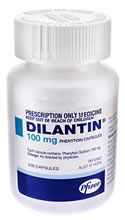 A U.S. Food and Drug Administration (FDA) Peripheral and Central Nervous System Drugs Advisory Committee warns that patients who take the anti-seizure medication Dilantin (phenytoin) are at risk of developing a condition known as purple glove syndrome, named because hands become painful, swell and change color to violet or purple.
A U.S. Food and Drug Administration (FDA) Peripheral and Central Nervous System Drugs Advisory Committee warns that patients who take the anti-seizure medication Dilantin (phenytoin) are at risk of developing a condition known as purple glove syndrome, named because hands become painful, swell and change color to violet or purple.
What is Purple Glove Syndrome?
According to a 2008 report issued by the FDA, the Dilantin may increase the risk of a condition known as purple glove syndrome. Though the name is odd, purple glove syndrome is so named because this Dilantin side effect causes the skin of the arms to discolor and during purple, causing a patient to look as if they are wearing gloves. In addition to discoloration, purple glove syndrome causes pain and local swelling.
According to a medical study conducted at the Mayo Clinic, approximately 6 percent of their study patients receiving intravenous Dilantin subsequently developed purple glove syndrome. Furthermore, this study found that purple glove syndrome is common among older patients and those who are regularly receiving high doses of Dilantin or generic phenytoin.
If a patient develops purple glove syndrome following a Dilantin injection, they will often take between two and four weeks to heal. Often, the discoloration and swelling will gradually subside; however, some patients experience significant pain and may suffer some tissue death associated with this Dilantin side effect.
Dilantin Side Effects Include Stevens Johnson Syndrome
Dilantin has been used intravenously since 1956. However, this medication has been recalled several times due to concern over serious potential side effects, including a life-threatening skin reaction known as Stevens Johnson Syndrome (SJS).
Stevens Johnson Syndrome is characterized by flu-like symptoms followed by a potentially life-threatening rash similar to a burn, open sores and skin peeling. Other SJS symptoms include a rash that spreads, painful blisters of the mucus membranes, blisters on the eyes, nose, mouth, and genitals, sloughing off of skin in large patches, joint and muscle pain and a burning sensation all over the body.
A study of 15 burn centers across the United States found that Dilantin side effects were believed to be the cause of more than 20 percent of SJS rash cases. Between 5 percent and 15 percent of SJS patients die from SJS side effects while survivors face a host of other medical problems including cellulitis, sepsis, blindness, internal organ damage and permanent skin damage.
FDA Warning About Dilantin Side Effects
In 2008, the FDA published a list of 20 drugs it was investigating for adverse side effects. One of them was Dilantin (phenytoin), for which the agency had received reports of purple glove syndrome. Purple glove syndrome was first diagnosed more than 20 years ago and has since been linked to at least 46 Dilantin patients. Some experts contend that the painful side effect is underreported and may actually afflict some 6 percent of Dilantin patients.
In 2010, the FDA committee issued a recommendation that new warnings should be placed on Dilantin, cautioning about the potential for purple glove syndrome. The following year, the FDA issued a safety label change to the Dilantin warning label, cautioning of local toxicity, including signs of purple glove syndrome — soft tissue irritation, swelling, tenderness and sloughing — though the symptoms may not occur until several days after the injection.
Do YOU have a legal claim? Fill out the form on this page now for a free, immediate, and confidential case evaluation. The SJS attorneys who work with Top Class Actions will contact you if you qualify to let you know if an individual lawsuit or Dilantin class action lawsuit is best for you. [In general, Dilantin lawsuits are filed individually by each plaintiff and are not class actions.] Hurry — statutes of limitations may apply.
ATTORNEY ADVERTISING
Top Class Actions is a Proud Member of the American Bar Association
LEGAL INFORMATION IS NOT LEGAL ADVICE
Top Class Actions Legal Statement
©2008 – 2025 Top Class Actions® LLC
Various Trademarks held by their respective owners
This website is not intended for viewing or usage by European Union citizens.
Get Help – It’s Free
Help for Victims of Stevens Johnson Syndrome
If you or a loved one were diagnosed with Stevens Johnson Syndrome (SJS) or toxic epidermal necrolysis (TEN) after taking a prescribed or over-the-counter medication, you may be eligible to take legal action against the drug’s manufacturer. Filing an SJS lawsuit or class action lawsuit may help you obtain compensation for medical bills, pain and suffering, and other damages. Obtain a free and confidential review of your case by filling out the form below.
An attorney will contact you if you qualify to discuss the details of your potential case at no charge to you.
Oops! We could not locate your form.












